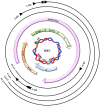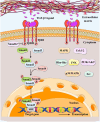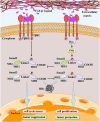Hepatitis B virus X protein and TGF-β: partners in the carcinogenic journey of hepatocellular carcinoma
- PMID: 38962270
- PMCID: PMC11220127
- DOI: 10.3389/fonc.2024.1407434
Hepatitis B virus X protein and TGF-β: partners in the carcinogenic journey of hepatocellular carcinoma
Abstract
Hepatitis B infection is substantially associated with the development of liver cancer globally, with the prevalence of hepatocellular carcinoma (HCC) cases exceeding 50%. Hepatitis B virus (HBV) encodes the Hepatitis B virus X (HBx) protein, a pleiotropic regulatory protein necessary for the transcription of the HBV covalently closed circular DNA (cccDNA) microchromosome. In previous studies, HBV-associated HCC was revealed to be affected by HBx in multiple signaling pathways, resulting in genetic mutations and epigenetic modifications in proto-oncogenes and tumor suppressor genes. In addition, transforming growth factor-β (TGF-β) has dichotomous potentials at various phases of malignancy as it is a crucial signaling pathway that regulates multiple cellular and physiological processes. In early HCC, TGF-β has a significant antitumor effect, whereas in advanced HCC, it promotes malignant progression. TGF-β interacts with the HBx protein in HCC, regulating the pathogenesis of HCC. This review summarizes the respective and combined functions of HBx and TGB-β in HCC occurrence and development.
Keywords: HBx protein; TGF-β signaling; hepatitis B virus; hepatocellular carcinoma; pro-tumorigenic; tumor suppressor.
Copyright © 2024 Yan, Rao, Fan, Liang, Zhang and Dong.
Conflict of interest statement
The authors declare that the research was conducted in the absence of any commercial or financial relationships that could be construed as a potential conflict of interest.
Figures






Similar articles
-
Hepatitis B virus X protein shifts human hepatic transforming growth factor (TGF)-beta signaling from tumor suppression to oncogenesis in early chronic hepatitis B.Hepatology. 2009 Apr;49(4):1203-17. doi: 10.1002/hep.22765. Hepatology. 2009. PMID: 19263472
-
c-Jun N-terminal kinase inhibitor favors transforming growth factor-β to antagonize hepatitis B virus X protein-induced cell growth promotion in hepatocellular carcinoma.Mol Med Rep. 2016 Feb;13(2):1345-52. doi: 10.3892/mmr.2015.4644. Epub 2015 Dec 4. Mol Med Rep. 2016. PMID: 26648552 Free PMC article.
-
The novel HBx mutation F30V correlates with hepatocellular carcinoma in vivo, reduces hepatitis B virus replicative efficiency and enhances anti-apoptotic activity of HBx N terminus in vitro.Clin Microbiol Infect. 2019 Jul;25(7):906.e1-906.e7. doi: 10.1016/j.cmi.2018.11.017. Epub 2018 Nov 23. Clin Microbiol Infect. 2019. PMID: 30472417
-
Hepatitis B virus X protein mediated epigenetic alterations in the pathogenesis of hepatocellular carcinoma.Hepatol Int. 2022 Aug;16(4):741-754. doi: 10.1007/s12072-022-10351-6. Epub 2022 Jun 1. Hepatol Int. 2022. PMID: 35648301 Review.
-
Hepatitis B virus X protein-induced aberrant epigenetic modifications contributing to human hepatocellular carcinoma pathogenesis.Mol Cell Biol. 2013 Aug;33(15):2810-6. doi: 10.1128/MCB.00205-13. Epub 2013 May 28. Mol Cell Biol. 2013. PMID: 23716588 Free PMC article. Review.
Cited by
-
The role of pioneering transcription factors, chromatin accessibility and epigenetic reprogramming in oncogenic viruses.Front Microbiol. 2025 Jun 16;16:1602497. doi: 10.3389/fmicb.2025.1602497. eCollection 2025. Front Microbiol. 2025. PMID: 40589575 Free PMC article. Review.
-
RRM2 Regulates Hepatocellular Carcinoma Progression Through Activation of TGF-β/Smad Signaling and Hepatitis B Virus Transcription.Genes (Basel). 2024 Dec 6;15(12):1575. doi: 10.3390/genes15121575. Genes (Basel). 2024. PMID: 39766842 Free PMC article.
-
The Antiviral Activity of Polyphenols.Mol Nutr Food Res. 2025 Aug;69(15):e70042. doi: 10.1002/mnfr.70042. Epub 2025 Apr 1. Mol Nutr Food Res. 2025. PMID: 40166854 Free PMC article. Review.
-
Pathogenesis, prevention, and therapeutic advances in hepatitis B, C, and D.Virol J. 2025 Aug 11;22(1):274. doi: 10.1186/s12985-025-02907-3. Virol J. 2025. PMID: 40790753 Free PMC article. Review.
References
Publication types
LinkOut - more resources
Full Text Sources

